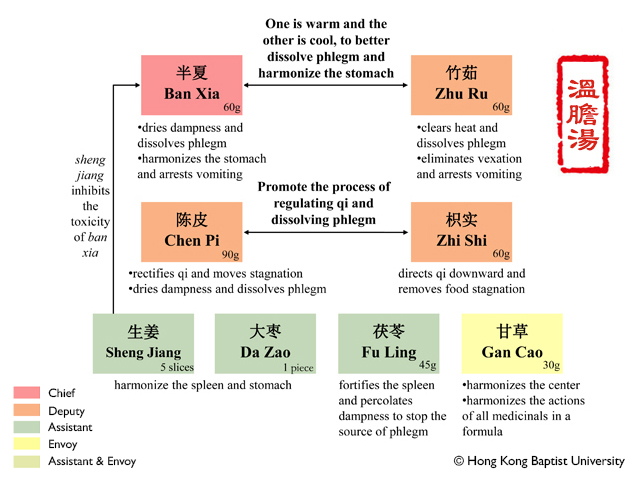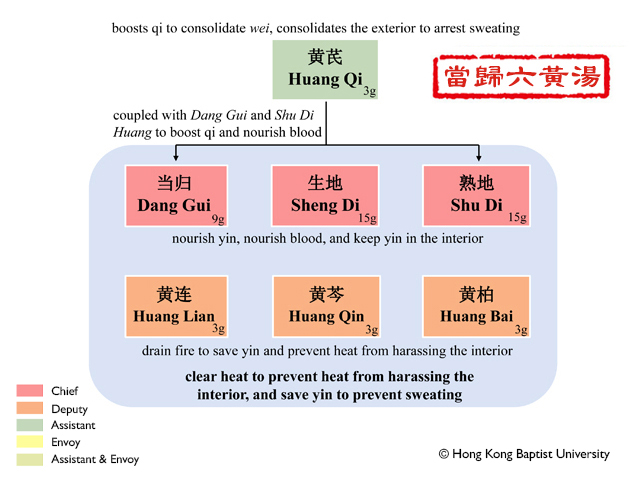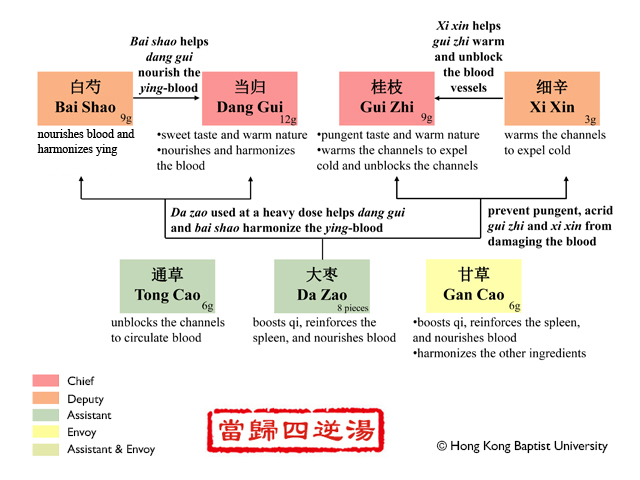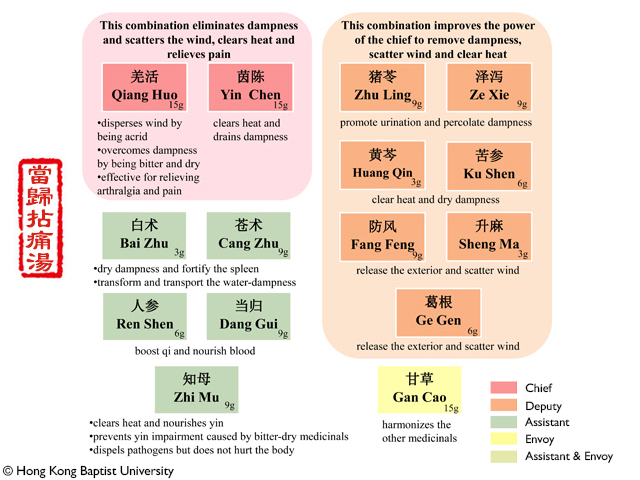| Numbering |
|
Name |
|
Combination |
|
Action |
|
Indication |
|
Thumbnail |
|
145
|
|
Gallbladder-Warming Decoction
|
|
Pinelliae Rhizoma; Bambusae Caulis in Taenias; Citri Reticulatae Pericarpium; Aurantii Fructus Immaturus; Poria; Glycyrrhizae Radix et Rhizoma Praeparata cum Melle; Zingiberis Rhizoma Recens; Jujubae Fructus
|
|
Rectifies qi and dissolves phlegm, harmonizes the stomach and promotes gallbladder secretion.
|
|
Wen Dan Tang is designed for patterns of gallbladder constraint with phlegm stirring up. This patterns manifest timidity and patients may be easily frightened. Other symptoms include vexation, insomnia or dreaminess, nausea, vomiting and hiccup, vertigo, epilepsy. The tongue coating is white and greasy, and the pulse is wiry and slippery.
|
|

|
|
146
|
|
Chinese Angelica Six Yellow Decoction
|
|
Angelicae Sinensis Radix; Rehmanniae Radix; Scutellariae Radix; Phellodendri Chinensis Cortex; Coptidis Rhizoma; Rehmanniae Radix Praeparata; Astragali Radix
|
|
Nourishes yin, drains fire, consolidates the exterior, and arrests sweating.
|
|
This formula is indicated for night sweating caused by yin deficiency and intense fire. The symptoms are night sweating with fever, red complexion, vexation, thirst and dry lips, dry stool, dark urine, a red tongue body with a yellow coating, and a rapid pulse.
|
|

|
|
147
|
|
Chinese Angelica Frigid Extremities Decoction
|
|
Angelicae Sinensis Radix; Cinnamomi Ramulus; Paeoniae Radix Alba; Asari Radix et Rhizoma; Glycyrrhizae Radix et Rhizoma; Tetrapanacis Medulla; Jujubae Fructus
|
|
Warms the channels to expel cold, nourishes the blood and unblocks the channels.
|
|
Counterflow cold of the limbs due to blood deficiency is characterized by counterflow cold of hands and feet, pain in the waist, thighs, lower legs, feet, shoulders, and back, no thirst, a pale tongue body with a white coating, and a deep, thin pulse or thin, impalpable pulse.
|
|

|
|
148
|
|
Chinese Angelica Pain-Alleviating Decoction
|
|
Notopterygii Rhizoma et Radix; Saposhnikoviae Radix; Cimicifugae Rhizoma; Puerariae Lobatae Radix; Atractylodis Macrocephalae Rhizoma; Atractylodis Rhizoma; Angelicae Sinensis Radix; Ginseng Radix et Rhizoma; Glycyrrhizae Radix et Rhizoma; Sophorae Flavescentis Radix; Scutellariae Radix; Anemarrhenae Rhizoma; Artemisiae Scopariae Herba; Polyporus; Alismatis Rhizoma
|
|
Drains dampness and clears heat, scatters wind and relieves pain.
|
|
Dang Gui Nian Tong Tang is indicated for patterns that arise due to a conflict between dampness and heat with concurrent external wind contraction. The symptoms are aching pain of limbs and joints, heavy sensation of the shoulder and back, swelling and pain of the feet, sores on the feet and knees. The tongue coating is white and greasy mixed with yellow and the pulse is wiry and rapid.
|
|

|

